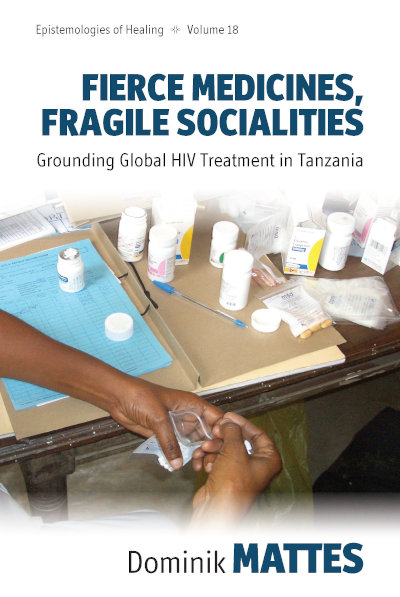Reviewed Book
Fierce Medicines, Fragile Socialities: Grounding Global HIV Treatment in Tanzania. Dominik Mattes, New York: Berghahn Books, 2019, 436 pp.

In Fierce Medicines, Fragile Socialities, Dominik Mattes patiently constructs a comprehensive and vivid picture of what it means to be “living with ARVs” (antiretroviral medicines) in Tanzania. In the 1990s and early 2000s, AIDS in sub-Saharan Africa was a death sentence, accompanied by visible physical deterioration and painful stigmatization. In the mid-2000s, when lifesaving treatment became available to most Africans, antiretroviral therapy (ART) transformed lives, including those in Tanga, Tanzania where Mattes’s fieldwork took place. As the book states up front, ART has been widely successful in scope and scale. It has allowed people living with HIV to fulfill social responsibilities, repair relationships, attend school, and hold down jobs.
Yet, for all its successes, ART has been accompanied by a parallel harm that goes well beyond the many side effects of the medicines themselves. According to Mattes, while ART extends and improves lives in immeasurable ways, it also “interferes in the moral sphere by meticulously stipulating patients’ desirable conduct and subjectivities” (p. 3). As medical anthropologists have long observed, people process biomedical information through their local realities. In exploring Tanzanians’ “local moral worlds,” Mattes helps make sense of why some people delay ART initiation, default on their medical regimens, or refuse treatment altogether. In this methodically researched and empathetically written ethnography, Mattes brings to life the ways that public health policies and practices set by transnational intergovernmental agencies trickle down into everyday morals—sometimes intact, but more often fracturing and distorting as they interact with complex local realities. He blurs the lines between structural constraints and lived experiences by exploring “the complexities and vicissitudes of affected people’s lifeworlds and fundamental moral concerns” (p. 17). In doing so, Mattes accomplishes what is best about anthropology: He makes seemingly illogical behavior appear logical when put in context.
From a methodological standpoint, Mattes has left no stone unturned in this thorough exploration of ARVs and ART provision. He makes every conceivable effort to transparently and carefully consider how his positionality and recruitment strategies might impact the people he encounters. He often takes painstakingly difficult routes to finding interlocutors to reduce power imbalances or any semblance of coercion from his interactions with the Tanzanians he is studying. This is particularly important given the range of actors and organizations with whom he works. While Fierce Medicines, Fragile Socialities is at times a hospital ethnography, it also takes place in villages, homes, community organizations, support groups, and churches. The heart of the book resides in the extended case studies, where Mattes makes space for his interlocutors and their varying experiences of initiating ART, caring and being cared for, disclosing their illness to loved ones, and struggling with side effects, stigma, fear, grief, love, sex, reproduction, and death. In the most poignant example, Mattes explores the surprisingly varying experiences and outcomes of several members of the same family, reminding readers of the ways that HIV/AIDS and ART reverberates through families, creating both solidarity and discord.
The singular accomplishment of Mattes’s Fierce Medicines, Fragile Socialities is the impressive range of perspectives that are presented with ethnographic richness and empathy throughout the book’s eight chapters. In a carefully built scaffold, each chapter covers the challenges and successes of a diverse set of actors and perspectives. After providing the historical and political economic context in which ART rollout occurred in Tanga, Mattes then turns his attention to the ways in which HIV treatment policies and guidelines play out in clinical spaces. The first few ethnographic chapters vividly show the impossibility of the work to be done by health care providers. Mattes provides poignant descriptions of the nearly insurmountable challenges in organization, reporting requirements by funding agencies, personnel shortages, and supply chain issues. Yet, he also vividly demonstrates how the immense pressure on health care providers often leads to marked power imbalances between them and their patients, and to increased surveillance of patients, who are required to “realign many central domains of their life in relation to biomedical rationality” (p. 169). At least in the clinical spaces described by Mattes, patients were not empowered to make informed decisions about their treatment, disclosure of their HIV status, or their sexual activity; rather, they were expected to make the “right” choices. However, in the privacy of their homes, Mattes’ interlocutors made a variety of decisions about how (and if) they wanted to live with ARVs, to whom they wanted to disclose their HIV status, and how it impacted their sex lives. In a series of powerfully and ethnographically moving chapters, Mattes explores how people make decisions about their treatment as they attempt to normalize their lives with HIV. While ARVs and ART provision are constantly evolving as they respond to market changes, recommendations of the World Health Organization, local realities, and the uncertainties inherent in globally funded health care interventions, Dominik Mattes’s stunning new book will remain relevant for those interested in why and how vertical global health interventions often fail (and how they might succeed). This book effectively illustrates how to translate the global to the local and the structural to the personal. Mattes also provides a blueprint for ethnographic research that aims to examine a problem from multiple, often contradictory, angles. Fierce Medicines, Fragile Socialities is a must read for those interested in HIV/AIDS, global health interventions, and ethnographic methods.